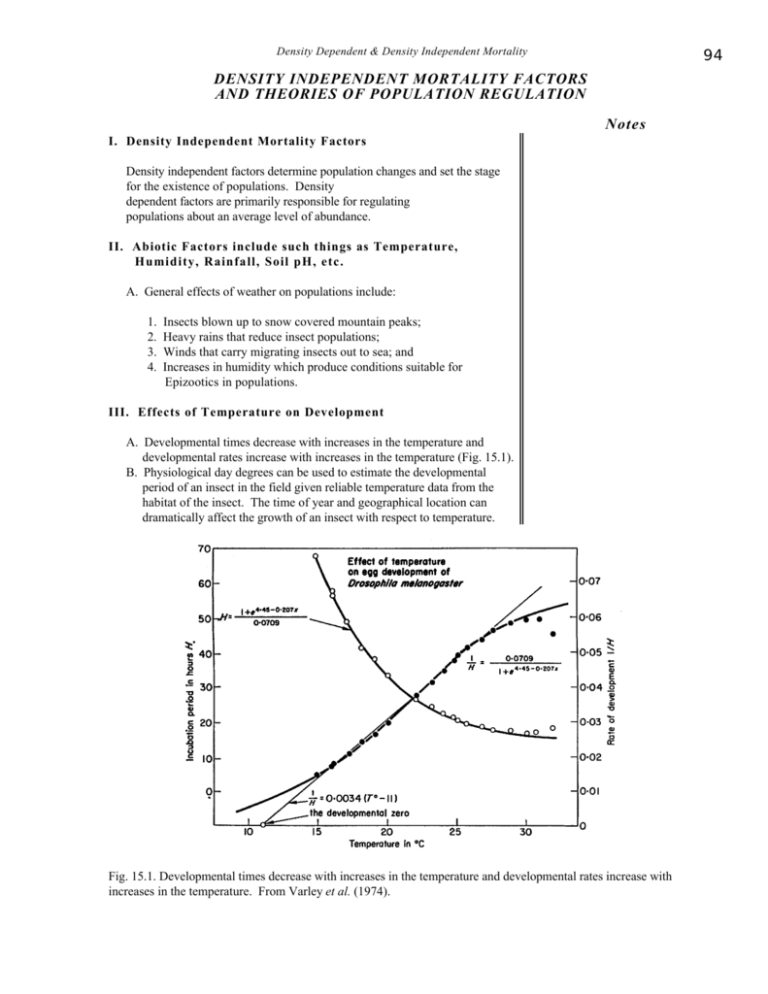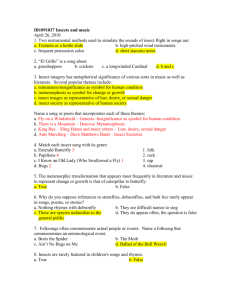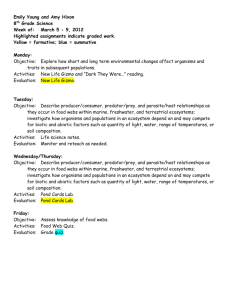94 DENSITY INDEPENDENT MORTALITY FACTORS AND
advertisement

94 Density Dependent & Density Independent Mortality DENSITY INDEPENDENT MORTALITY FACTORS AND THEORIES OF POPULATION REGULATION Notes I. Density Independent Mortality Factors Density independent factors determine population changes and set the stage for the existence of populations. Density dependent factors are primarily responsible for regulating populations about an average level of abundance. II. Abiotic Factors include such things as Temperature, Humidity, Rainfall, Soil pH, etc. A. General effects of weather on populations include: 1. 2. 3. 4. Insects blown up to snow covered mountain peaks; Heavy rains that reduce insect populations; Winds that carry migrating insects out to sea; and Increases in humidity which produce conditions suitable for Epizootics in populations. III. Effects of Temperature on Development A. Developmental times decrease with increases in the temperature and developmental rates increase with increases in the temperature (Fig. 15.1). B. Physiological day degrees can be used to estimate the developmental period of an insect in the field given reliable temperature data from the habitat of the insect. The time of year and geographical location can dramatically affect the growth of an insect with respect to temperature. Fig. 15.1. Developmental times decrease with increases in the temperature and developmental rates increase with increases in the temperature. From Varley et al. (1974). 95 Density Dependent & Density Independent Mortality Notes IV. Effects of Climate on Populations A. The combination of temperature, air movement, humidity, and rainfall can dramatically affect the success of a natural enemy in a given location. These variables considered together are equivalent to the term climate. B. Examples of poor climate fit for introduced natural enemies: 1. Walnut Aphid (Chromaphis juglandicola) in California. In 1959 a solitary endoparasitic wasp, Trioxys pallidus was imported from Nice, France. By 1960 it was established from San Diego to Lompoc along the coast and interdiate valleys. Unfortunately it did not control the pest in the intermediate valleys. From 1960 to 1964 the parasite was introduced into Northern California, but was not recovered in most places. The French strain of parasite was able to undergo both estival diapause in the summer and hibernal diapause in the winter. It was originally collected in the coastal regions of France. It was decided that the parasite was climatically unfit for many of the walnut growing areas of California. Climatographic analysis of Nice, France suggests that the summer heat and possible dryness of Northern California and interior valleys of Southern California constituted the limiting factor in the spread of the parasite. A strain of T. pallidus imported from Teheran, Iran, by van den Bosch resulted in successful biological control in Northern California and the interior valleys. Climatographic analysis showed that Teheran was similar in climate patterns to Northern California walnut growing areas. The Persian strain had no summer diapause. 2. Alfalfa weevil, Hypera postica in California. This insect is distributed in 2 discontinuous areas in the state. One area in Northern California has "Great Basin Type" climate. In the southern areas there is a mild coastal pattern to typical continental, hot dry, cold-wet condition of California interior areas. Around San Francisco there is a difference in the climate due to the interruption of the coastal marine influence by a series of relatively low, North-South mountain chains (Coastal Range). A parasite, Bathyplectes curculionis, was introduced in 1934 for control. It was a solitary endoparasitic ichneumonid. Prior to parasite's release, the alfalfa weevil was most abundant in the intermediate Coastal Range and least prevalent in the Central Valley. After the parasite's introduction, the weevil was least abundant in the Bay area and most abundant in the Central Valley. Good biological control was achieved. In the Bay area the parasite is active year round due to cool, humid summer conditions. In the Central Valley it is strongly suppressed by the summer heat. 96 Density Dependent & Density Independent Mortality Notes V. Theories of Population Regulation and Change A. Various theories have been suggested by noted insect population ecologists as to the way insect populations are regulated. The most warranted theories have been suggested by Nicholson, Andrewartha and Birch, Milne, Pimentel, and Huffaker. B. Nicholson: Divided controling factors into: 1. Density-legislative factors ("rule making") which was equivalent to density independent factors ("non-reactive" factors). 2. Density-governing factors ("rule enforcing") which was equivalent to density dependent factors. He believed that intraspecific competition was most important in regulating populations. C. Andrewartha and Birch: They rejected the subdivision of the environment into physical and biotic factors because they did not believe it was a useful framework. They did work on 2 species in particular: 1. Swarmforming grasshopper, Austroicetes cruciata. Hypothesized that its distribution and abundance was determined by weather (Fig. 15.2). 2. Apple blossom thrips, Thrips imaginis. No density dependent factors could be found which controlled this species. See figure on page 1 of notes. D. Milne: Took a "middle of the road" stance. He believed that abundance was a product of density independent and "imperfectly" density dependent factors. He considered intraspecific competition as the ultimately perfect density dependent factor. E. Pimentel: Concept of "genetic feedback". Agreed with the concepts of density dependence and density independence and proposed that genetic feedback worked within the system. Genetic feedback: slight genetic change in host population which keeps it slightly ahead of the parasite until the natural enemy catches up by genetic change. Fig. 15.2. Crosshatched bars represent the years in which the Australian plague locust, Chortoicetes terminifera, swarmed. The rainfall index was obtained by multiplying the total number of inches of rain from October to February by the number of those months in which there was more than 2 inches of rain (zero counting as 0.5 in.) Data were collected at BoganMacquarie, New South Wales, Australia. Figure from Varley et al. (1974); see for more information. 97 Density Independent Mortality Factors Notes F. Huffaker: Divided environment into Conditioning Forces (Legislative factors) and Governing Mechanisms (Governing factors). 1. Conditioning forces: environmental factors or agents which, unifluenced by density, contribute to setting of fixing of a framework of potential environmental capacity or affect interim population realization when capacity is not attained. 2. Governing Mechanisms: the actions of repressive environmental factors, collectively or singly, which intensify as the population density increases and relax as this density falls. Huffaker saw conditioning forces as setting up a frame in which the governing mechanisms worked. QUESTIONS 1. How does climate impact the success of a biological control project? Provide examples to illustrate your point. 2. Discuss the major points in the theories of population regulation proposed by 1) Nicholson; 2) Andrewartha and Birch; 3) Milne; Huffaker; and Pimentel. 3. Does climate regulate arthropod populations? Defend your answer. REFERENCES Clark, L. R., P. W. Geier, R. D. Hughs & R. F. Morris. 1967. The ecology of insect populations in theory and practice. Methuen and Co. Ltd., London. 232 pp. Huffaker, C. B. & P. S. Messenger. 1964. The concept and significance of natural control. p. 74–117. In Biological Control of Insect Pests and Weeds (P. DeBach, editor). Chapman and Hall Ltd., London. 844 pp. Huffaker, C. B., F. J. Simmonds & J. E. Laing. 1976. The theoretical and empirical basis of biological control. p. 41–78. In Theory and Practice of Biological Control (C. B. Huffaker and P. S. Messenger, editors). Academic Press, N. Y. 788 pp. M e s s e n g e r , P . S . 1 9 7 0 . Bioclimatic inputs to biological control and pest management programs. p. 84102. In Concepts of Pest Management (R. L. Rabb and F. E. Guthrie, editors). Proc. North Carolina State University, Raleigh, NC. March 25–27, 1970. 242 pp. P r i c e , P . W . 1 9 7 5 . Insect Ecology. John Wiley & Sons, N. Y. 514 pp. Varley, G. C., G. R. Gradwell & M. P. Hassell. 1974. Insect population ecology - an analytical approach. Univ. Calif. Press, Berkeley and Los Angeles. 212 pp. van den Bosch, R., P. S. Messenger & A. P. Gutierrez. 1982. An introduction to biological control. Plenum Press, N. Y. 247 pp. Van Driesche, R. G. and T. S. Bellows, Jr. 1996. Biological control. Chapman and Hall, New York. 539 pp. READING ASSIGNMENT: Chapter 18: pp. 367–398, Van Driesche, R. G. and T. S. Bellows, Jr. 1996. Biological control. Chapman and Hall, New York. 539 pp.







